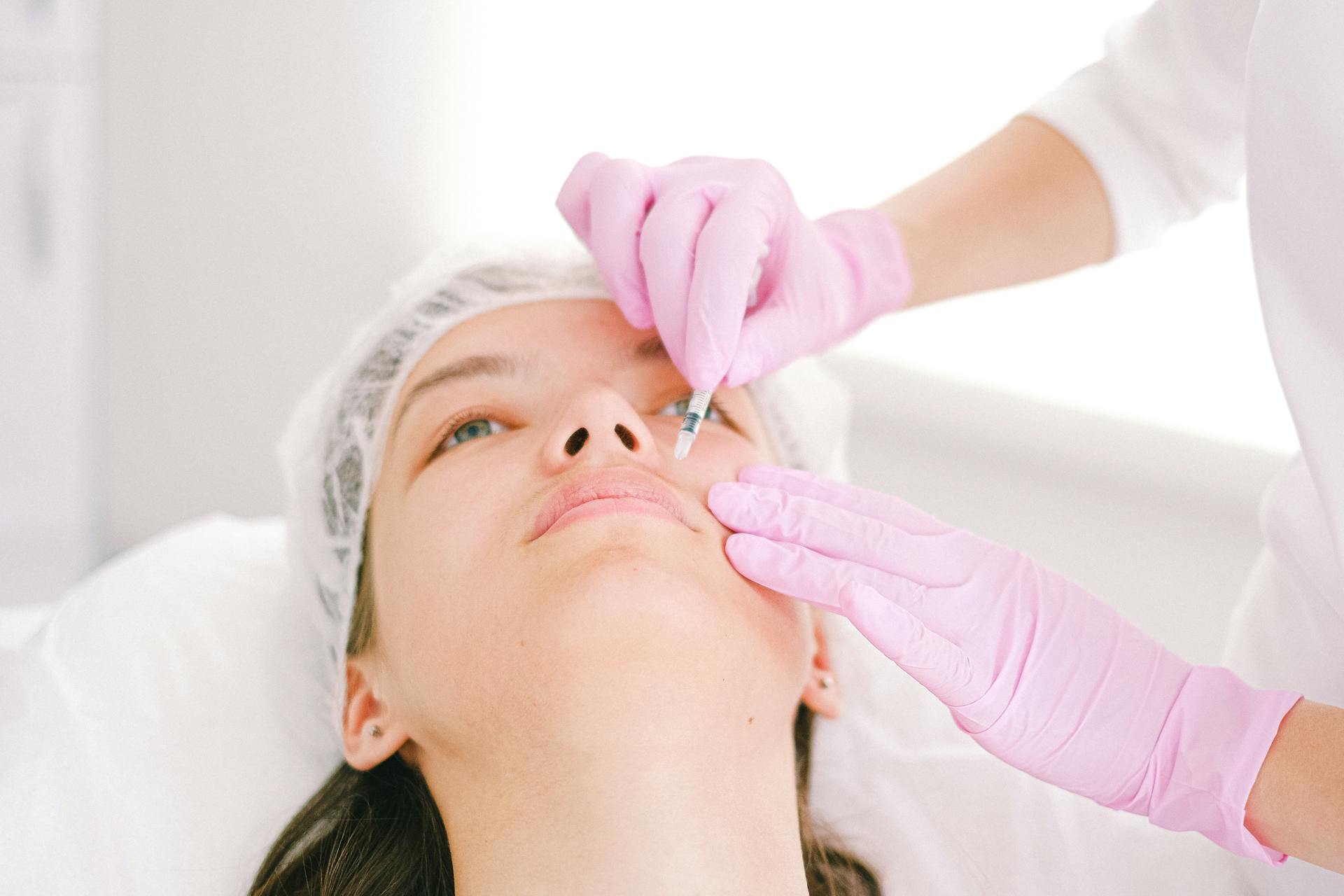
Insurance coverage for Botox can vary greatly depending on the provider and policy.
In the United States, Botox is approved by the FDA for the treatment of migraines, but insurance coverage is not guaranteed. Some insurance plans may cover Botox for migraines, while others may not.
According to a study, 75% of insurance plans covered Botox for migraines, but the coverage amount varied widely. The average out-of-pocket cost for Botox injections was $1,300 per year.
Insurance Coverage
Your health insurance probably covers Botox if you need it for medical reasons. Botox is approved to treat certain health issues, including chronic migraines, specific types of muscle stiffness, and severe underarm sweating.
You may need to show proof that other treatments didn't work before your health insurance will pay for Botox. This is a common requirement for many medical treatments.
You'll probably still have to pay for some of your treatment in the form of a deductible, copay, or coinsurance. The amount you have to pay will be different depending on your health insurance plan.
Cost and Savings
The cost of Botox for migraines can vary greatly depending on your insurance situation. If you have insurance, Botox usually costs up to $163.
However, the cost without insurance can be much higher, ranging from $300 to $600 for a 155-unit treatment, or up to $1,200 for a 200-unit vial.
But don't worry, there are some savings programs available. The Botox Savings Program can help pay for the costs your health insurance doesn't cover. If you qualify, you might not have to pay anything for your treatment.
To qualify, you need to meet five eligibility requirements: be currently getting Botox for an approved condition, have health insurance from your employer or a private health insurance company, not be eligible for or enrolled in Medicare, Medicaid, or any other federal or state health care program, be 18 or older (or the parent of someone under 18 getting Botox), and be getting your Botox treatment in the U.S. or its territories.

Here's a breakdown of the estimated costs with Medicare:
- Overactive bladder: $33 per month
- Chronic migraines: $196 for a 12-week treatment
- Other conditions: costs vary
Keep in mind that if you're on Medicare, you don't qualify for the Botox Savings Program. But Botox is covered under Medicare Part B, which usually pays for about 80% of your medical care, leaving you to pay the remaining 20%.
Migraine and Treatment
Most insurance plans cover Botox for chronic migraine relief, including Medicare and Medicaid, although you'll still need to pay a co-pay.
The FDA approved Botox for migraine relief in 2010, and studies have shown that patients experience fewer days with headaches each month after undergoing Botox injections.
Almost every insurance plan covers Botox for chronic migraine relief, but you may need to undergo prior authorization, which can take several weeks or even a few months.
To get Botox covered by insurance, you'll need a diagnosis of chronic migraine and have tried at least two other migraine preventatives before being approved for Botox injections.

Some insurance companies require proof of effectiveness, such as a 30% or 50% response in frequency, improvement in quality of life scales, or a proof of effectiveness of previous treatments.
You'll typically still need to pay for some of your treatment in the form of a deductible, copay, or coinsurance, depending on your health insurance plan.
Here are the common criteria for insurance companies to cover Botox:
- A diagnosis of Chronic Migraine
- Previous trial and failure or side effects with 1 or more migraine preventive medications
Keep in mind that some insurance companies may only cover Botox for migraines if you've tried other treatments first, so it's essential to work with your healthcare provider and insurance provider to ensure you have all the necessary documentation.
Authorization and Process
Insurance companies often require extra steps before covering Botox treatments for migraines, a process called prior authorization.
To get Botox covered by insurance, you'll need to establish medical necessity, which involves documenting your medical condition and previous treatments.
Prior authorization can be a lengthy process, and insurance companies may still refuse coverage or charge a co-pay that's too expensive.
Government Plans

Government plans can be a bit tricky to navigate, but I've got the lowdown. BOTOX for chronic migraine is covered under the Alberta government drug plan.
If you live in Ontario, it may be covered if you meet specific criteria, which can be found in this document. To apply, go here.
In Quebec, a patient d'exception form must be completed and submitted, which can be accessed here. This form needs to be filled out by a physician.
CADTH changed its recommendation in 2019 to cover BOTOX if certain criteria are met, which is a big improvement. Prior to 2019, the recommendation was not to cover, making it difficult for people with public insurance to access BOTOX.
INESSS, the equivalent of CADTH in Quebec, also made a positive recommendation to cover BOTOX in 2019, which should make access easier. This was after reevaluating data, including new research and safety data since 2011.
In BC, the Pharmacare BC institution is currently reviewing BOTOX, and Migraine Canada provided input for this process.
Prior Authorization
Prior authorization is a process that can be a hurdle for those seeking treatment for chronic migraines. It's a step that requires extra paperwork and documentation before insurance companies agree to cover the cost of medication.
Insurance companies often require patients to try other treatments before approving medication like anti-CGRP migraine medication or Botox. This means that patients need to have documented proof that other treatments have failed.
The process of prior authorization can be lengthy and time-consuming. Patients may need to talk to their insurance provider and their healthcare provider to get the necessary documentation. Some medication manufacturers offer co-pay programs called "bridges" to help patients access medication while waiting for prior authorization.
However, these programs come with risks, such as the possibility of insurance companies refusing to cover the medication or charging a high co-pay. Patients on government insurance like Medicaid or Medicare are not eligible for bridge programs.
It's essential for patients to understand the prior authorization process and to work closely with their healthcare provider to navigate it. By doing so, they can increase their chances of getting the treatment they need.
How It Works

Botox works by temporarily paralyzing the muscles that overactive nerves supply. This helps to decrease migraine frequency by preventing migraines before they start.
The chemical acetylcholine is responsible for sending signals between nerve cells, and Botox blocks its release. This can help to reduce or even eliminate migraine headaches.
Botox injections are usually given every 12 weeks, and the number of injections and location will depend on the severity of migraines.
Frequently Asked Questions
What diagnosis is covered for Botox?
Botox is medically necessary for conditions like chronic migraine, strabismus, overactive bladder, dystonia, and excessive underarm sweating. If you have one of these conditions, Medicare Part B may help cover the procedure.
Sources
- https://migrainebuddy.com/how-to-get-botox-for-migraines-covered-by-insurance/
- https://www.youthbar.com/beauty-and-aesthetics-blog/how-to-get-botox-covered-by-insurance
- https://www.valuepenguin.com/health-insurance-botox
- https://migrainecanada.org/posts/the-migraine-tree/branches/preventive-treatments/botox-coverage-and-access-in-canada/
- https://www.pain-spine.com/2022/08/16/botox-injections-for-migraine-headaches-insurance-coverage-and-beyond/
Featured Images: pexels.com

